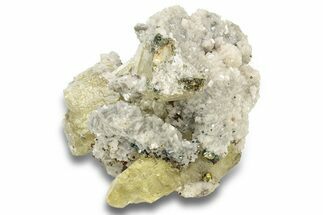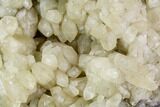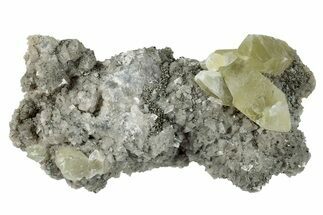This Specimen has been sold.
11.1" Calcite Crystal Clusters on Dolomite Matrix - Missouri
This specimen contains clusters of light yellow colored calcite crystals of various sizes, all scattered throughout a dolomite rich matrix. An aggregation of beautifully formed dolomite crystals can be observed on what could be considered the underside of this specimen. This mineral cluster was collected from Joplin, Missouri. The longest calcite crystal is 2" long.
Under long and short wave UV, the calcite crystals display a faint yellow fluorescence.
From the Mark Gottlieb collection.
Under long and short wave UV, the calcite crystals display a faint yellow fluorescence.
From the Mark Gottlieb collection.
Calcite, CaCO3, is a carbonate mineral and the most stable polymorph of calcium carbonate. The other polymorphs are the minerals aragonite and vaterite. Calcite crystals are trigonal-rhombohedral, though actual calcite rhombohedra are rare as natural crystals. However, they show a remarkable variety of habits including acute to obtuse rhombohedra, tabular forms, and prisms. Calcite exhibits several twinning types adding to the variety of observed forms. It may occur as fibrous, granular, lamellar, or compact. Cleavage is usually in three directions parallel to the rhombohedron form.
Dolomite is an anhydrous carbonate mineral composed of calcium magnesium carbonate (CaMg(CO3)2).
The mineral dolomite crystallizes in the trigonal-rhombohedral system. It forms white, tan, gray, or pink crystals. Dolomite is a double carbonate, having an alternating structural arrangement of calcium and magnesium ions. It does not rapidly dissolve in dilute hydrochloric acid as calcite does. Crystal twinning is common.
Dolomite was first described by Carl Linnaeus in 1768, and in 1791 it was described as a rock by the French naturalist and geologist Déodat Gratet de Dolomieu. He first recognized the material in buildings of the old city of Rome, and later as samples collected in the mountains known as the Dolomite Alps of northern Italy.
The mineral dolomite crystallizes in the trigonal-rhombohedral system. It forms white, tan, gray, or pink crystals. Dolomite is a double carbonate, having an alternating structural arrangement of calcium and magnesium ions. It does not rapidly dissolve in dilute hydrochloric acid as calcite does. Crystal twinning is common.
Dolomite was first described by Carl Linnaeus in 1768, and in 1791 it was described as a rock by the French naturalist and geologist Déodat Gratet de Dolomieu. He first recognized the material in buildings of the old city of Rome, and later as samples collected in the mountains known as the Dolomite Alps of northern Italy.
SPECIES
Calcite & Dolomite
LOCATION
Joplin, Missouri
SIZE
11.1 x 6.8 x 4.3"
CATEGORY
ITEM
#110301
 Reviews
Reviews















